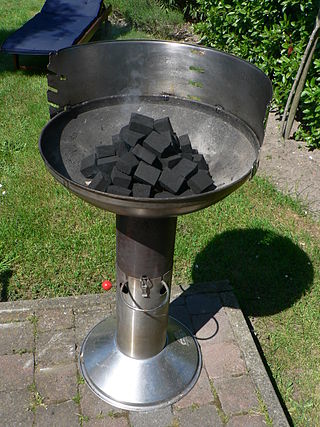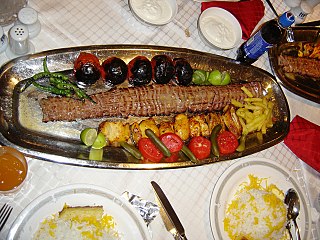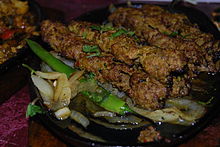
Turkish cuisine is the cuisine of Turkey and the Turkish diaspora. Although the cuisine took its current rich form after numerous cultural interactions throughout centuries, it should not be confused with other cuisines such as Ottoman cuisine or Seljuk cuisine. Turkish cuisine with traditional Turkic elements such as yogurt, ayran, kaymak, exerts and gains influences to and from Mediterranean, Balkan, Middle Eastern, Central Asian and Eastern European cuisines.

Satay, or sate in Indonesian spelling, is a Southeast Asian form of kebab made from seasoned, skewered and barbecued meat, served with a sauce.

Offal, also called variety meats, pluck or organ meats, is the internal organs of a butchered animal. The word does not refer to a particular list of edible organs, and these lists of organs vary with culture and region, but usually exclude skeletal muscle. Offal may also refer to the by-products of milled grains, such as corn or wheat.

Kebab, kabob, kebap, or kabab (Kashmir) is roasted meat that originates from the Middle East. Many variants of the category are popular around the world, including the skewered shish kebab and the doner kebab with bread.

Pakistani cuisine can be characterized as a blend of regional cooking styles and flavours from across South, Central and Western Asia. Pakistani cuisine is influenced by Persian, Indian, and Arab cuisine. The cuisine of Pakistan also maintains certain Mughal influences within its recipes and cooking techniques. Pakistan's ethnic and cultural diversity, diverse climates, geographical environments, and availability of different produce lead to diverse regional cuisines.

Punjabi cuisine is a culinary style originating in the Punjab, a region in the northern part of South Asia, which is now divided in an Indian part to the east and a Pakistani part to the west. This cuisine has a rich tradition of many distinct and local ways of cooking.

Pasanda, also called Parche, is a popular dish from the Indian subcontinent, notably North India, Rampur, Hyderabadi and Pakistani, derived from a meal served in the court of the Mughal emperors. The word is a variation on the Hindi-Urdu word "pasande" meaning "favourite", which refers to the prime cuts of meat traditionally used in the dish.

Levantine cuisine is the traditional cuisine of the Levant, in the sense of the rough area of former Ottoman Syria. The cuisine has similarities with Egyptian cuisine, North African cuisine and Ottoman cuisine. It is particularly known for its meze spreads of hot and cold dishes, most notably among them ful medames, hummus, tabbouleh and baba ghanoush, accompanied by bread.

Barbecue varies by the type of meat, sauce, rub, or other flavorings used, the point in barbecuing at which they are added, the role smoke plays, the equipment and fuel used, cooking temperature, and cooking time.

Kabab koobideh or Kobide is an Iranian type of kofta kabab made from ground lamb or beef, often mixed with ground pepper and chopped onions.

Kabāb-e Barg is a Persian style barbecued and marinated lamb, chicken or beef kabab dish. The main ingredients of Kabab-e Barg are beef tenderloin, lamb sirloin, or less commonly chicken breast, along with onions and olive oil.

Afghan cuisine is influenced to a certain extent by Persian, Central Asian and Indian cuisines due to Afghanistan's close proximity and cultural ties. The cuisine is halal and mainly based on mutton, beef, poultry and fish with rice and Afghan bread. Accompanying these are common vegetables and dairy products, such as milk, yogurt, and whey, and fresh and dried fruits such as apples, apricots, grapes, bananas, oranges, plums, pomegranates, sweet melons, and raisins. The diet of most Afghans revolves around rice-based dishes, while various forms of naan are consumed with most meals. Tea is generally consumed daily in large quantities, and is a major part of hospitality. The culinary specialties reflect the nation's ethnic and geographic diversity. The national dish of Afghanistan is Kabuli palaw, a rice dish cooked with raisins, carrots, nuts, and lamb or beef.

Sate kambing is the Indonesian name for "mutton satay". It is part of the cuisine of Indonesia. This food is made by grilling goat meat that has been mixed with seasoning. The dish is also called lamb satay and goat satay.

Bun kebab or anda shami is a sandwich that originated in Pakistan, but is now popular all throughout the Indian subcontinent. Bun kebabs are a signature in Pakistani metro cities like Karachi and Lahore, but they can be found all over Pakistan. Bun Kebab vendors are scattered all across Karachi, vendors on Burns Road being particularly famous, and imitated by frozen bun kebabs sold in South Asian supermarkets across the world. In India, it is eaten as a regular street food, specifically, in the Indian cities of Bhopal, Lucknow, and Hyderabad; it is especially popular with Indian Muslims, the dish is eaten late-night during Ramadan. Bun kebabs are usually sold from roadside stalls, side street vendors, and fast food restaurants. They are also commonly known as anday wala burger. A ‘fried’ version of the bun kebab is popular in Lahore, known as ‘bun plaster’ due to copious amounts of butter and super tender or paste-like kebab mixture used in it. Bun kebabs are usually eaten as a main course or snack.

Mughlai cuisine consists of dishes developed or popularised in the early-modern Indo-Persian cultural centres of the Mughal Empire. It represents a combination of cuisine of the Indian subcontinent with the cooking styles and recipes of Central Asian and Islamic cuisine. Mughlai cuisine is strongly influenced by the Turkic cuisine of Central Asia, the region where the early Mughal emperors originally hailed from, and it has in turn strongly influenced the regional cuisines of Northern India, Pakistan and Bangladesh.

Javanese cuisine is the cuisine of Javanese people, a major ethnic group in Indonesia, more precisely the province of Central Java, Yogyakarta and East Java.
Awadhi cuisine is a cuisine native to the Awadh region in Northern India and Southern Nepal. The cooking patterns of Lucknow are similar to those of Central Asia, the Middle East, and Northern India and western India with the cuisine comprising both vegetarian and non-vegetarian dishes. The Awadh region has been influenced by Mughal cooking techniques, and the cuisine of Lucknow bears similarities to those of Central Asia, Kashmir, Punjab and Hyderabad. The city is also known for its Nawabi foods.

Sundanese cuisine is the cuisine of the Sundanese people of Western Java, and Banten, Indonesia. It is one of the most popular foods in Indonesia. Sundanese food is characterised by its freshness; the famous lalab eaten with sambal and also karedok demonstrate the Sundanese fondness for fresh raw vegetables. Unlike the rich and spicy taste, infused with coconut milk and curry of Minangkabau cuisine, the Sundanese cuisine displays the simple and clear taste; ranged from savoury salty, fresh sourness, mild sweetness, to hot and spicy.

Omani cuisine is part of the Khaleeji cuisine and is influenced by Arab, Pakistani cuisine, Iranian, Indian, Asian, Eastern Mediterranean, and African cuisine, reflecting Oman's position as a vast trading empire at the intersection of traditional spice trade routes. Dishes are often based on chicken, fish, and lamb, as well as the staple of rice. Most Omani dishes tend to contain a rich mixture of spices, herbs, and marinades. Omani cuisine differs from other cuisines in the Arabian peninsula, as it is less spicy and seldom served warm.



















